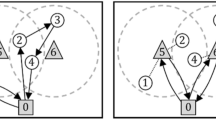Abstract
In this paper, we explore same-day delivery routing and particularly how same-day delivery vehicles can better integrate dynamic requests into delivery routes by taking advantage of preemptive depot returns. A preemptive depot return occurs when a delivery vehicle returns to the depot before delivering all of the packages currently on-board the vehicle. In this paper, we assume that a vehicle serves requests in a particular delivery area. Beginning the day with some known deliveries, the vehicle seeks to serve the known requests as well as additional new requests that are received throughout the day. To serve the new requests, the vehicle must return to the depot to pick up the packages for delivery. In contrast to previous work on same-day delivery routing, in this paper, we allow the vehicle to return to the depot before serving all loaded packages. To solve the problem, we couple an approximation of the value of choosing any particular subset of requests for delivery with a routing heuristic. Our approximation procedure is based on approximate dynamic programming and allows us to capture both the current value of a subset selection decision and its impact on future rewards. Using extensive computational tests, we demonstrate the value of preemptive depot returns and the value of the proposed approximation scheme in supporting preemptive returns. We also identify characteristics of instances for which preemptive depot returns are most likely to offer improvement.








Similar content being viewed by others
References
Azi N, Gendreau M, Potvin J-Y (2012) A dynamic vehicle routing problem with multiple delivery routes. Ann Oper Res 199(1):103–112
Barto AG (1998) Reinforcement learning: an introduction. MIT Press, Cambridge
Bent RW, Van Hentenryck P (2004) Scenario-based planning for partially dynamic vehicle routing with stochastic customers. Oper Res 52(6):977–987
Berbeglia G, Cordeau J-F, Laporte G (2010) Dynamic pickup and delivery problems. Eur J Oper Res 202(1):8–15
Bertsimas DJ, Chervi P, Peterson M (1995) Computational approaches to stochastic vehicle routing problems. Transp Sci 29(4):342–352
BI Intelligence (2017) National retail federation estimates 8-12 2017. [Online; accessed 10 Nov 2017]
Ehmke JF, Campbell AM (2014) Customer acceptance mechanisms for home deliveries in metropolitan areas. Eur J Oper Res 233(1):193–207
Ehmke JF, Campbell AM, Urban TL (2015) Ensuring service levels in routing problems with time windows and stochastic travel times. Eur J Oper Res 240(2):539–550
Ghiani G, Manni E, Quaranta A, Triki C (2009) Anticipatory algorithms for same-day courier dispatching. Transp Res Part E Logist Transp Rev 45(1):96–106
Ghiani G, Manni E, Romano A (2017) Scalable anticipatory policies for the dynamic and stochastic pickup and delivery problem. Submitted for publication
Ghiani G, Manni E, Thomas BW (2012) A comparison of anticipatory algorithms for the dynamic and stochastic traveling salesman problem. Transp Sci 46(3):374–387
Goodson JC, Thomas BW, Ohlmann JW (2016) Restocking-based rollout policies for the vehicle routing problem with stochastic demand and duration limits. Transp Sci 50(2):591–607
Goodson JC, Thomas BW, Ohlmann JW (2017) A rollout algorithm framework for heuristic solutions to finite-horizon stochastic dynamic programs. Eur J Oper Res 258(1):216–229
Hyytiä E, Penttinen A, Sulonen R (2012) Non-myopic vehicle and route selection in dynamic darp with travel time and workload objectives. Comput Oper Res 39(12):3021–3030
Kall P, Wallace S (1994) Stochastic programming. Wiley, New York
Keyes D (2017) E-commerce will make up 17 company is the main reason. [Online; accessed 10 Nov 2017]
Klapp MA, Erera AL, Toriello A (2016) The dynamic dispatch waves problem for same-day delivery. Submitted for publication
Klapp MA, Erera AL, Toriello A (2018) The one-dimensional dynamic dispatch waves problem. Transp Sci 52(2):402–415
Larsen A, Madsen O, Solomon M (2002) Partially dynamic vehicle routing-models and algorithms. J Oper Res Soc 53(6):637–646
Mes M, van der Heijden M, Schuur P (2010) Look-ahead strategies for dynamic pickup and delivery problems. OR Spectr 32(2):395–421
Mitrović-Minić S, Laporte G (2004) Waiting strategies for the dynamic pickup and delivery problem with time windows. Transp Res Part B Methodol 38(7):635–655
Muñoz Carpintero D, Sàez D, Corès CE, Núñez A (2015) A methodology based on evolutionary algorithms to solve a dynamic pickup and delivery problem under a hybrid predictive control approach. Transp Sci 49(2):239–253
Powell W (2011) Approximate dynamic programming: solving the curses of dimensionality, 2nd edn. Wiley, Hoboken
Pureza V, Laporte G (2008) Waiting and buffering strategies for the dynamic pickup and delivery problem with time windows. INFOR Inf Syst Oper Res 46(3):165–176
Rosenkrantz DJ, Stearns RE, Lewis P (1974) Approximate algorithms for the traveling salesperson problem. In: IEEE conference record of 15th annual symposium on switching and automata theory, 1974. IEEE, pp 33–42
Sáez D, Cortés CE, Núñez A (2008) Hybrid adaptive predictive control for the multi-vehicle dynamic pick-up and delivery problem based on genetic algorithms and fuzzy clustering. Comput Oper Res 35(11):3412–3438
Secomandi N (2003) Analysis of a rollout approach to sequencing problems with stochastic routing applications. J Heurist 9(4):321–352
Thomas K (2017) CVS will offer next-day delivery of prescription drugs. [Online; accessed 10 Nov 2017]
Ulmer MW, Thomas BW (2018) Enough waiting for the cable guy-estimating arrival times for service vehicle routing. Transp Sci (to appear)
Ulmer MW, Goodson JC, Mattfeld DC, Thomas BW (2017) Dynamic vehicle routing: literature review and modeling framework (under review)
Ulmer MW, Goodson JC, Mattfeld DC, Hennig M (2018a) Offline-online approximate dynamic programming for dynamic vehicle routing with stochastic requests. Transp Sci. https://doi.org/10.1287/trsc.2017.0767
Ulmer MW, Mattfeld DC, Köster F (2018b) Budgeting time for dynamic vehicle routing with stochastic customer requests. Transp Sci 52(1):20–37
Voccia SA, Campbell AM, Thomas BW (2017) The same-day delivery problem for online purchases. Transp Sci. https://doi.org/10.1287/trsc.2016.0732
Wahba P (2017) Best buy and Macy’s ramp up same-day delivery in race with Amazon. [Online; accessed 10 Nov 2017]
Yahoo! Finance (2016) Increased value-added services expected to boost the same-day delivery market in the US, says Technavio. Yahoo! Finance. http://finance.yahoo.com/news/increased--value--added--services--expected--204000803.html. Accessed 14 Jul 2016
Yang W, Mathur K, Ballou R (2000) Stochastic vehicle routing problem with restocking. Transp Sci 34(1):99–112
Author information
Authors and Affiliations
Corresponding author
Additional information
The authors would like to thank the Associate Editor and the anonymous reviewers.
Appendix
Appendix
In the Appendix, we present instance generation details, the PDR-algorithm as well as the results and parameters for every instance setting.
1.1 Instance generation details
In the following, we describe how the realizations for the computational evaluation are generated. The number of customers and the order times for a realization are generated by a Poisson process \(\mathfrak {P}\). With \(c_0\) the expected number of IOs, the number of IOs is generated by \(\mathfrak {P}(c_0)\). The spatial and temporal probability distribution for order times and locations is divided into two independent probability distributions. The times of SO occurrences are (discretely) uniformly distributed \(t \sim U_\mathbb {Z}[1,t_{\text {max}}-1]\). Customer locations \(f(C) \in \mathcal {A}\) are realizations \(f \sim \mathcal {F}\) of the spatial probability distribution \(\mathcal {F}: \mathcal {A}\rightarrow [0,1]\). A realization of the order time is again conducted by a Poisson process \(\mathfrak {P}\) for every minute \(0<t<t_{\text {max}}\). Given two points of time \(0<t^j<t^h<t_{\text {max}}\), this results in an expected number of customers of \(c^{t^h}_{t^j}=\mathbb {E}_{\omega \in \Omega }\left| \{C^{\omega }_i \in \mathcal {C}^{\omega }_+:t^j<t_i\le t^h\}\right|\) ordering in times \(t^j<t_i\le t^h\) as described in Eq. (9).
1.2 Preemptive depot returns: algorithm
This section presents a detailed algorithm for the PDR routing heuristic that was described in Sect. 4.3. Let \(\mathcal {D}\) denote the depot, \(\mathcal {P}_k\) the vehicle’s position, \(C_l\) the loaded IOs. Further, we let \(C_n\) represent the assigned unloaded SOs. The current planned tour can then be described as
Let \(\theta ^j_k\) refer to the jth component of \(\theta _k\), e.g., \(\theta ^1_k=\mathcal {P}_k\). Further, let \(\mathcal {C}_r=\{C^1_r,\dots ,C^h_r\}\) be the subset of new SOs to assign. PDR first removes the depot from \(\theta _k\) leading to an infeasible tour \(\bar{\theta }\). In this infeasible tour, the customers \(\mathcal {C}_r\) are subsequently inserted via CI at the cheapest position. Procedure \(\textit{Insert}(\bar{\theta },\theta ^*,C^*)\) inserts the new order \(C^*\) after \(\theta ^*\) in tour \(\bar{\theta }\). When all new customers are inserted, the depot is inserted between the current position and the first not loaded customer (\(C_n\) or \(C_r\)) via CI resulting in a tour \(\theta ^x_k\). If \(\theta ^x_k\) does not violate the time limit, the tour is feasible. We assume an initial tour \(\theta _0=(\mathcal {D},\mathcal {D})\) without customers, starting and ending at the depot.

1.3 Detailed results
In this section, we present the detailed results for the computational experiments discussed in Sect. 6. The first table presents the average number of assignments for APDR and each benchmark over all realizations for each instance setting. The second table presents the average number of depot returns, the average time required for a depot return, and the initial free time budget over all realizations for each instance setting for APDR.
Rights and permissions
About this article
Cite this article
Ulmer, M.W., Thomas, B.W. & Mattfeld, D.C. Preemptive depot returns for dynamic same-day delivery. EURO J Transp Logist 8, 327–361 (2019). https://doi.org/10.1007/s13676-018-0124-0
Received:
Accepted:
Published:
Issue Date:
DOI: https://doi.org/10.1007/s13676-018-0124-0




